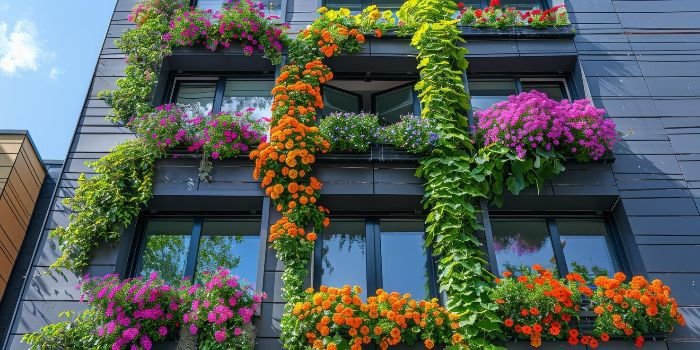Do you want to make your outdoor space look great and well-designed? Are you looking for tips to improve your garden’s look? If yes, learning basic landscape design principles is key for you as a home gardener.
Landscape design principles help you plan and beautify your garden. They guide you in choosing the right layout and elements for your space. By using these principles, you can turn your garden into a beautiful place.
In this article, we’ll cover the main landscape design principles for home gardeners. We’ll talk about planning and the basic elements of design. You’ll get practical advice and tips to make your garden look good and work better.
Whether you’re starting fresh or updating your garden, this guide will give you the skills and ideas to design your dream garden. Let’s explore landscape design principles and bring out the best in your home garden.
Key Takeaways:
- Understanding landscape design principles is essential for home gardeners.
- Applying these principles can transform your garden into a visually appealing and well-planned space.
- From the importance of planning to the key elements of landscape design, this article will provide you with practical tips.
- By implementing these principles, you can create a garden that is both beautiful and functional.
- Whether you are a beginner or an experienced gardener, these principles will guide you in designing your dream garden.
Table of Contents
Understanding Landscape Design
Creating a stunning garden starts with understanding landscape design. It’s key whether you’re starting fresh or redoing an old space. A well-planned garden turns your outdoor area into a beautiful oasis.
The Importance of Planning
Planning is the first step in successful landscape design. You need to think about your goals and look at your garden space. Then, make a plan that includes key elements for a beautiful design.
Planning helps your garden match your home’s look and your needs. It lets you pick the right plants and design features. This way, you can avoid mistakes and keep your garden looking great with less work.
It also means thinking about things like sunlight, soil, drainage, and how plants will grow. This makes your garden sustainable and easy to care for.
Key Elements of Landscape Design
Key elements make up landscape design:
- Unity and Harmony: Making your garden look connected and balanced.
- Balance and Symmetry: Using plants and stones to create balance.
- Focal Points: Highlighting certain areas or features in your garden.
- Rhythm and Movement: Making your garden feel like it moves with plants and paths.
- Proportion and Scale: Making sure everything fits well in your garden.
Using these elements in your garden design makes your outdoor space beautiful and functional. It also makes your home look better.
Assessing Your Garden Space
Before you start designing your garden, it’s key to understand what you’re working with. Look closely at your garden’s unique features. This helps you make smart choices during design and setup. We’ll show you how to assess your garden, including checking site conditions, understanding microclimates, and mapping out what’s already there.
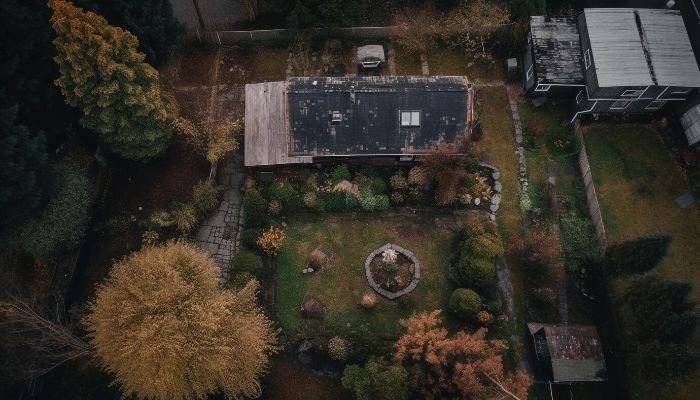
Analyzing Site Conditions
Start by looking at your garden’s site conditions. Note the soil quality, how much sun it gets, how well it drains, and where the wind blows. Knowing these things helps you make your garden better for plants.
Understanding Microclimates
Microclimates are small areas in your garden with their own weather. They can be affected by the sun, trees, and even the ground you walk on. Knowing about these spots lets you pick plants that will do well there. It also helps you plan your garden better.
Mapping Out Existing Features
It’s also important to map out what’s already in your garden. This means drawing a plan that shows trees, paths, patios, and any water features. This helps you see your garden’s layout and where you might need to make changes. It lets you keep what you like and make it work with your new design.
The image above shows why analyzing your garden is key to a great design. It helps you use your garden space to its fullest.
Setting Goals for Your Garden
Setting clear goals for your garden is key in the design process. Define your garden’s purpose, think about maintenance, and set a budget. This way, you can make a beautiful and useful outdoor space that fits your needs and wants.
Defining Your Garden’s Purpose
First, figure out what you want from your garden. Do you want a peaceful spot to relax? Or a garden full of fruits, veggies, and herbs for you to eat? Maybe you want to help wildlife by making a home for them.
Considering Maintenance Levels
Think about how much you can handle in terms of garden work. Some people love to spend hours in the garden. Others might not have much time or can’t do a lot of work. Knowing this helps you pick plants and designs that fit your life.
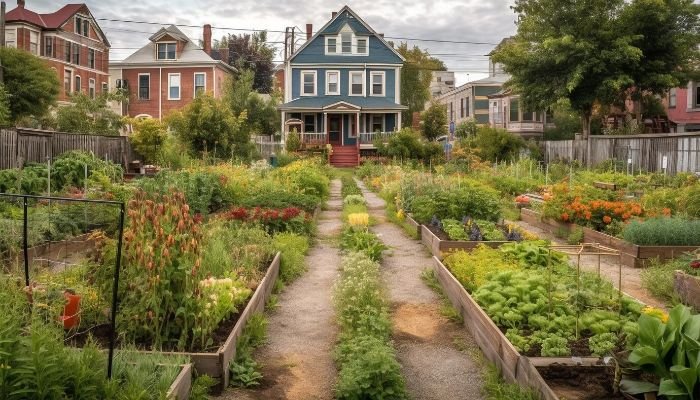
Establishing a Budget
It’s also important to think about your budget. Decide how much you can spend on your garden. This includes things like plants, materials, and upkeep costs. Having a budget helps you make smart choices and avoid spending too much. There are many ways to make a beautiful garden without spending a lot.
By setting clear goals for your garden, you can make a design that suits you. Think about what you want, how much work you can do, and what you can afford. This makes your garden better for living outside.
Principles of Landscape Design
The principles of landscape design help make outdoor spaces look great and feel peaceful. By using these principles, you can turn your garden into a beautiful and balanced place. Let’s look at some key ideas to make your landscape better.
Unity and Harmony
Unity and harmony are key in landscape design. They make your garden look connected and visually pleasing. Pick plants and materials that go well together. Use plants with similar colors, textures, and shapes.
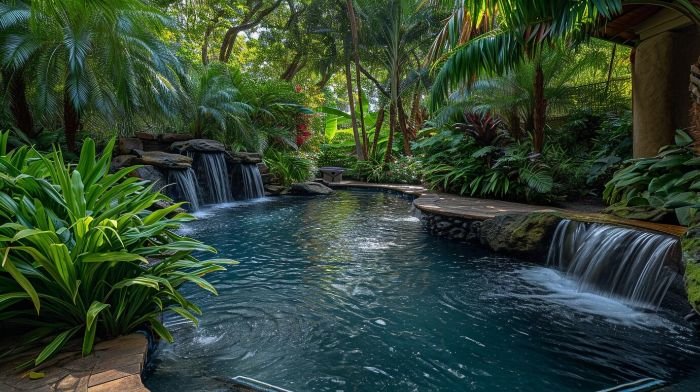
Match the hardscaping like paths and patios to add unity. This makes sure everything in your garden works well together. It creates a beautiful look.
Balance and Symmetry
Balance and symmetry are important in landscape design. They make your garden feel stable and orderly. There are two kinds of balance: symmetrical and asymmetrical.
Symmetrical balance means putting the same elements on both sides of a central line. Asymmetrical balance uses different sizes and shapes to look balanced. Using both types adds interest and beauty to your garden.
Focal Points
Focal points draw the eye and guide it through your garden. Use eye-catching things like sculptures, water features, or unique plants. Place these points carefully to make a big impact and add depth.
Rhythm and Movement
Rhythm and movement add flow and interest to your garden. Repeat shapes, colors, or patterns to create a rhythm. Use paths or curves to lead the eye around your garden.
This makes your outdoor space feel like an adventure.
Proportion and Scale
Proportion and scale are key for a balanced and pleasing garden. They mean choosing the right size and placement of elements. Think about your garden’s size and pick plants and features that fit well.
Understanding proportion and scale helps you create a garden that looks and feels right.
Designing Your Garden Layout
Designing your garden layout is key to a well-organized outdoor space. A systematic approach helps every part of your garden have a purpose. This section covers the basics of garden design, like making a base plan, zoning, pathways, patios, and water features.
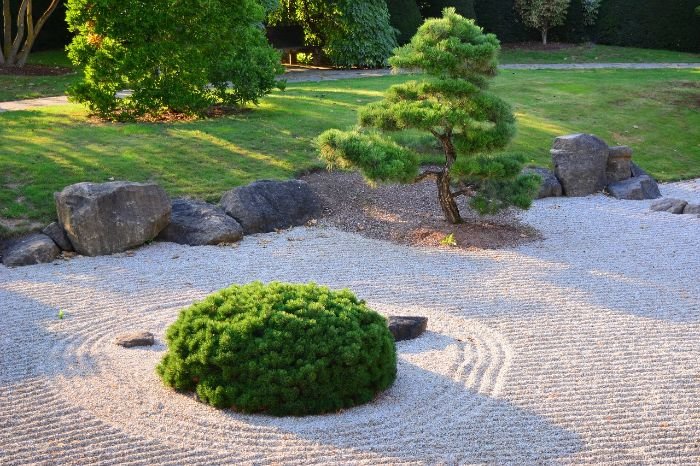
Creating a Base Plan
Start with a base plan that shows your garden’s current features. This blueprint helps you see the layout and spot areas to improve. Think about sunlight, shade, drainage, and existing structures when making your plan. This guides you in picking plants and designing your garden.
Zoning Your Space
Zoning means dividing your garden into areas for different uses. You might have spots for entertaining, gardening, or relaxing. This approach brings order and makes your garden more fun and useful. Use plants, hedges, or fences to mark zones and add interest and privacy.
Designing Pathways and Patios
Pathways and patios connect your garden, making it easy to move around and providing spots for activities. Design pathways with the flow of movement in mind and choose materials that fit your garden’s theme. Patios are great for sitting and socializing. Think about their size, shape, and location to match your garden.
Integrating Water Features
Water features bring beauty and calm to your garden. They can be ponds, fountains, or waterfalls. Pick a water feature that fits your garden’s size and maintenance needs. The right spot for water features can draw wildlife and create a peaceful feel.
Selecting Plants for Your Landscape
Choosing the right plants is key to a beautiful garden. Pick plants that fit your climate and know how big they’ll get. This way, your garden will look great for years. Also, mixing plants makes your garden more interesting and balanced.
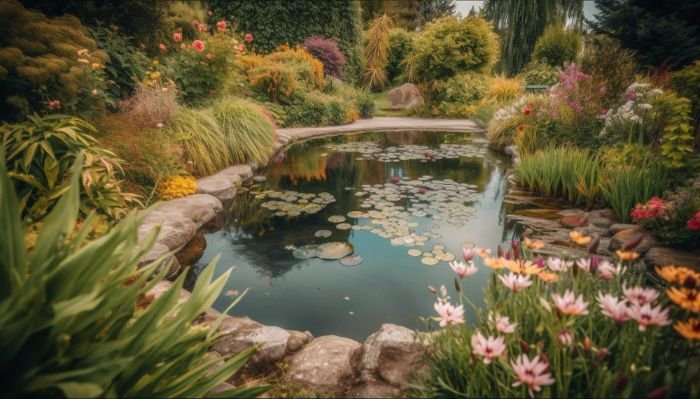
Choosing Plants Based on Climate
Think about your local climate when picking plants. Plants need different temperatures, sunlight, and moisture. Picking plants that fit your climate helps them grow well. Look at the USDA hardiness zone and your garden’s microclimates to help choose.
Considering Plant Size and Growth
Know how big and how fast plants will grow. This affects where and how you place them. Make sure plants have enough space to grow well and reach their full size.
Creating Plant Combinations
Combining plants makes your garden look better. Think about their colors, textures, and heights. Mixing different colors and textures adds depth. Varying heights creates layers. Try out different mixes to see what looks best.
By picking plants right for your climate, thinking about their size, and mixing them well, you can make a beautiful garden. This will improve your landscape’s look.
Hardscaping Elements
Incorporating Garden Structures
Hardscaping elements are key to a great garden design. Adding structures like pergolas, arbors, and trellises brings beauty and function. They add architectural interest and make your garden feel more organized.
Pergolas, arbors, and trellises are great for creating cozy spots or shade. They also help plants climb and add privacy. These structures make your garden look better and work harder for you.
Trellises are great for climbing plants or as decorations. They can stand alone or be attached to walls or fences. Adding these structures makes your garden more interesting and useful.
Choosing Materials for Paths and Patios
Choosing the right materials for paths and patios is important. These elements are both useful and add beauty to your garden. Popular choices include gravel, flagstone, brick, and concrete pavers.
Gravel gives a natural look, while flagstone is more rustic. Brick adds a classic feel. Concrete pavers are versatile and can match your garden’s style.
For patios, think about your garden’s theme and how much upkeep you want. Natural stone like granite or slate offers luxury. Concrete slabs are modern and easy to maintain. Consider durability and upkeep when picking materials.
Using Decorative Elements
Decorative elements can make your garden stand out. Things like statues, fountains, and lights add personality and focus. They make your garden more interesting and unique.
Statues can be placed to draw the eye and set a mood. They can be classic or modern, adding art to your garden. They become talking points with guests.
Fountains bring peace and attract wildlife. The sound of water creates a calm space. Choose a fountain that fits your garden’s size and style.
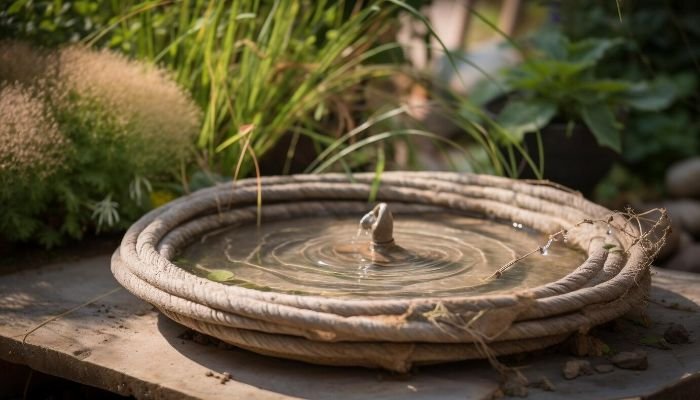
Outdoor lighting is key for both looks and function. Lights on paths or around seating areas make your garden magical at night. They let you enjoy your garden longer.
With these hardscaping elements, your garden will be beautiful and useful. Garden structures, the right materials for paths and patios, and decorative touches will make it an oasis.
Sustainable Landscape Design
Sustainable landscape design makes outdoor spaces beautiful and nature-friendly. It uses water-wise gardening, native plants, and organic gardening. This approach helps reduce our impact on the environment.
Water-Wise Gardening
Water-wise gardening is key to sustainable design. It uses efficient irrigation and captures rainwater. Choosing drought-tolerant plants also helps. This saves water, cuts down on bills, and makes landscapes more sustainable.
Using Native Plants
Native plants fit well in their local areas. They need less water and care. These plants help local wildlife by offering food and shelter.
Creating Wildlife Habitats
Adding wildlife habitats to your garden helps local biodiversity. It makes your garden more beautiful and interesting. With birdhouses and native plants, you can attract many animals. These habitats are good for birds, butterflies, and bees.
Practicing Organic Gardening
Organic gardening means growing plants without synthetic chemicals. It uses natural fertilizers and pest control. This keeps your garden healthy and safe for the environment.
Implementing Your Design
Preparing the Site
After finalizing your garden design, it’s time to start bringing it to life. First, prepare the site. This means clearing the land, leveling it, and adjusting it for your design.
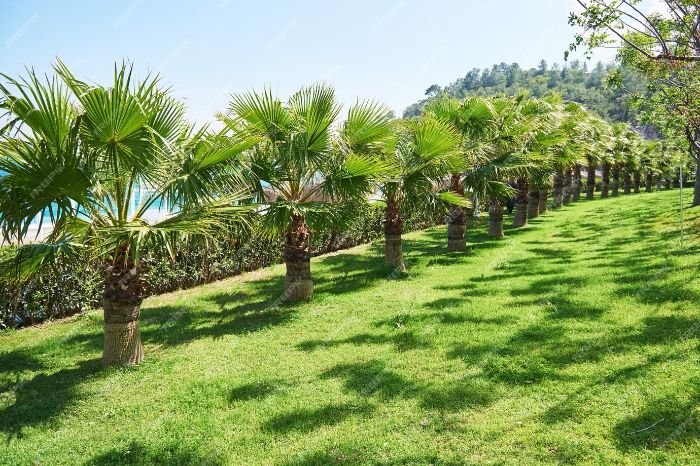
Check the soil and drainage before starting. This helps you know if you need to make changes for your plants. Clearing the land of weeds or tall grass lets you start fresh.
Grading the land is key for a level surface and to stop water from pooling. It also makes sure your paths and patios are stable and work well.
Planting and Hardscaping
With the site ready, it’s time for planting and hardscaping. Pick plants that fit your climate and consider their size and growth. This is key for a beautiful garden.
Put your plants in their spots, thinking about how they’ll grow and look with your design. Dig holes deep enough for their roots and fill with good soil.
Adding things like paths, patios, and structures makes your garden useful and pretty. Plan these carefully to match your garden’s look.
Adding Final Touches
As you finish your garden, add the final touches. Mulch around your plants makes them look better and keeps the soil moist. It also stops weeds.
Don’t forget about your paths and other hard features. Decorative lights, seats, or ornaments can make your garden look amazing.
Step back and look at your garden. Make any changes you need to make sure it looks just right.
Maintaining Your Garden
Keeping your garden healthy and looking good is key. Regular care makes sure your garden stays vibrant and peaceful. It turns into a lovely spot for you to enjoy.
Regular Maintenance Tips
Here are some important tips for keeping your garden in top shape:
- Garden Upkeep – Stay on top of cleaning by removing weeds, leaves, and debris. This stops pests and diseases from spreading.
- Watering – Water your plants the right amount to keep them healthy. Know how much different plants need and adjust as needed.
- Fertilizing – Give your plants the right food to grow strong. Use organic or slow-release fertilizers for best results.
- Pruning – Trim your plants to keep them looking good and healthy. Cut off dead or sick branches and trim back too much foliage.
- Pest Control: Watch for pests and deal with them safely. Use natural methods to protect good insects and wildlife.
Seasonal Garden Care
Seasonal care is also crucial for your garden. Each season has its own needs for your plants. Here are some seasonal tips:
- Spring – Clean up after winter, remove dead plants, and get the soil ready for new growth. Prune shrubs and trees to help them bloom well.
- Summer – Keep your garden hydrated during the heat. Mulch helps keep moisture in and stops weeds. Remove dead flowers to keep plants blooming.
- Fall – Get your garden ready for winter by cleaning up and planting cool-season crops. Use organic mulch to protect plants from frost.
- Winter – Protect plants from the cold by covering them or bringing them inside. Prune trees and shrubs to remove dead or crossing branches.
By following these tips for regular and seasonal care, your garden will stay beautiful all year.
Conclusion
Understanding landscape design basics is key to making a beautiful garden. By using these principles, you can make your outdoor space look great and work well. This makes your home look better and brings you happiness.
Plan well and think about your garden’s size and what you want. Use design principles to make a garden that looks good and lasts. Add things like unity, balance, and focal points for a nice look.
When designing, think about using hard landscaping and choosing plants that fit the climate and size. Mix plants that look good together. Use water-wise gardening and native plants for a green garden.
With the right care, your garden will grow and become a peaceful place. Enjoy making your dream garden. Your outdoor space will show your style and give you joy for many years.
FAQ
What are landscape design principles?
Landscape design principles help make outdoor spaces look good and work well. They include things like unity and harmony, balance and symmetry, and focal points. Rhythm and movement, and proportion and scale are also key.
Why are landscape design principles important for home gardeners?
These principles are key for home gardeners. They make sure gardens look great and are planned well. By using them, gardeners can make sure their gardens are cohesive and meet their needs.
How do I assess my garden space?
First, check your garden’s soil, sunlight, and drainage. Know about microclimates and what’s already there. This helps pick the right plants and arrange them well.
Why is goal-setting important in garden design?
Setting goals is crucial for garden design. It helps define what your garden is for. Whether it’s for relaxing, growing food, or helping wildlife, clear goals guide your choices.
How do I create a well-organized garden layout?
Start with a base plan that shows what’s there and thinks about sunlight and drainage. Zoning your space and adding paths and patios creates areas. Water features can also help organize your garden.
How do I implement my garden design?
First, clear the area and adjust it as needed. Plant and add hardscaping to bring your design to life. Finish with mulching, adding final touches, and fine-tuning your design.






